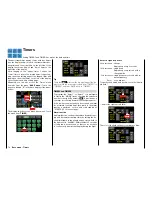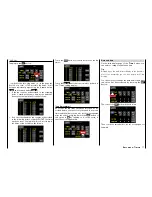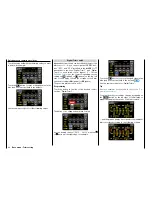
3. Place the model on a flat surface (concrete, mowed
lawn or ground) so that the receiver antennas are
at least 15 cm above the ground. It may therefore
be necessary to place a support underneath the
model during the test.
4. Hold the transmitter at hip level at a slight distance
from your body. Do not point the antenna direct-
ly at the model; rotate and/or bend the transmitter
antenna so that is it is approximately at a right an-
gle to the model.
5. Activate the range test mode by touching the but-
ton to the right of "RANGE TEST" with a finger or
the provided stylus, ...
Touch
... whereupon a safety query appears:
Touch
NO
to terminate the procedure. Touch
YES
to start the range test.
When the range test starts, the output of the trans-
mitter decreases significantly. At the same time,
the illuminated company name
Graupner
below
the two middle proportional dials starts to flash.
Simultaneously, the time display in the transmit-
ter display starts to count backwards and emits 2
beeps every 2 seconds.
5 seconds before the range test ends, 3 beeps ev-
ery second. After the 99-second range test, the
transmitter switches back to full output, and the
Graupner
logo shines continuously.
6. During this time, move away from the model, and
also move the transmitter's control elements. If
you detect an interruption in the link within a range
of about 50 m at any time, attempt to reproduce it.
7. If the model has a motor, turn it on to also check
interference resistance.
8. Move further away from the model until it does not
respond perfectly.
9. At this location, wait for the remainder of the test
period with the still operable model. The mod-
el should still react properly to control commands
once the range test is finished. If this is not 100 %
the case, do not use the system and contact your
Service at
Graupner/SJ
GmbH.
10. Perform a range test before each flight, and simu-
late all servo movements that could occur during
the flight. In order to guarantee a safe model oper-
ation, the range must always be at least 50 m on
the ground.
WARNING
Never start a range test on the transmit-
ter during normal model operation!
DSC OUTPUT
To set the modulation of your transmitter at the DNC
output, touch the button with the current setting in
the "DSC Output" line (repeatedly if necessary) un-
til the desired modulation appears. Four types of
modulation are available in this sequence: "PPM10",
"PPM16", "PPM18" and "PPM24":
Touch
The selected modulation primarily influences the band
width and the number of available control channels at
this DSC socket and hence a flight simulator or train-
er system connected to this socket. If "PPM10" is
selected, the channels are 1 … 5; with "PPM16", the
channels are 1 … 8, with "PPM18", the channels are
1 … 9, and with "PPM24", the control channels are 1
… 12.
72
Base menu - Transmitter setting
Summary of Contents for mz-24 PRO
Page 13: ...13 Personal notes...
Page 19: ...19 Personal notes...
Page 37: ...37 Personal notes...
Page 59: ...Touch 59 Base menu Model selection...
Page 79: ...79 Personal notes...
Page 89: ...89 Personal notes...
Page 115: ...115 Personal notes...
Page 153: ...Helicopter model function menus Common function menus 153 Personal notes...
Page 169: ...169 Personal notes...
Page 187: ...187 Personal notes...
Page 199: ...199 Personal notes...
Page 207: ...Fixed wing model function menus System menus 207 Personal notes...
Page 211: ...211 Personal notes...
Page 219: ...219 Personal notes...
Page 237: ...237 Personal notes...
Page 238: ...238 Personal notes...
Page 239: ...239 Personal notes...
















































